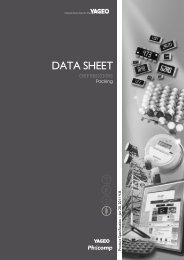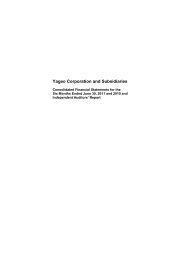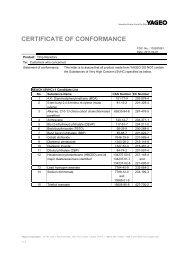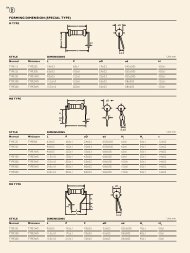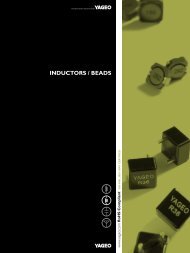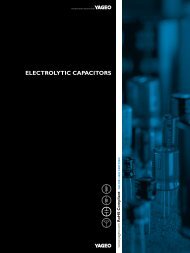MLCC replacements for tantalum capacitors - Yageo
MLCC replacements for tantalum capacitors - Yageo
MLCC replacements for tantalum capacitors - Yageo
Create successful ePaper yourself
Turn your PDF publications into a flip-book with our unique Google optimized e-Paper software.
<strong>MLCC</strong> <strong>replacements</strong> <strong>for</strong><strong>tantalum</strong> <strong>capacitors</strong>www.yageo.com
<strong>MLCC</strong> <strong>replacements</strong> <strong>for</strong> <strong>tantalum</strong> <strong>capacitors</strong>The past 5 to 10 years have seen increases of between10 and 100 fold in capacitance per unit volume <strong>for</strong> bothceramic multilayer <strong>capacitors</strong> and solid <strong>tantalum</strong><strong>capacitors</strong> (Refs 1 and 2). Figure 1 shows this increase<strong>for</strong> ceramic <strong>capacitors</strong>.As a result, the application areas<strong>for</strong> <strong>MLCC</strong>s have gradually extended into those <strong>for</strong>merlydominated by <strong>tantalum</strong> <strong>capacitors</strong> and these, in turn,have extended into even higher capacitance applicationareas <strong>for</strong>merly occupied by, <strong>for</strong> example, electrolytics.10priceindex1<strong>MLCC</strong> X7R<strong>MLCC</strong> Y5VMSD100A<strong>tantalum</strong>10 2cap/vol(mF/mm 3 )10 210 -21985 1990 1995 200010 2 MSD099Fig. 210 -1Cost reduction <strong>for</strong> 1 µF <strong>capacitors</strong>.2SUMMARYFor certain capacitance values, many circuitdesigners who traditionally use <strong>tantalum</strong><strong>capacitors</strong> might well find that their applicationis now better served by <strong>MLCC</strong>s. Moreover, theever higher production levels of <strong>MLCC</strong>s coupledwith new developments such as the introductionof base-metal electrodes have greatly reducedthe unit production cost of <strong>MLCC</strong>s.This meanson price too, they can now compete with<strong>tantalum</strong> <strong>capacitors</strong> in many applications.Fig. 110 -110 -210 -3Y5VX7R1980 1985 1990 1995 2000<strong>MLCC</strong> capacitance per unit volume increaseIn the area of overlap between 0.1 µF and 100 µF,there<strong>for</strong>e, the two technologies compete and manycircuit designers who traditionally use <strong>tantalum</strong><strong>capacitors</strong> might well find that their application is nowbetter served by <strong>MLCC</strong>s. The ever higher productionlevels of <strong>MLCC</strong>s (currently 600 billion annuallycompared with 25 billion <strong>for</strong> <strong>tantalum</strong> <strong>capacitors</strong>)coupled with new developments such as theintroduction of base-metal electrodes have also greatlyreduced the unit production cost of <strong>MLCC</strong>s, whichmeans on price too, they can now compete with<strong>tantalum</strong> <strong>capacitors</strong> in many applications.Figure 2 gives a schematic view of the price decreasebetween 1985 and 1995 <strong>for</strong> 1 µF <strong>capacitors</strong> in ceramicmultilayer and <strong>tantalum</strong> technology. In 1990,Y5V <strong>MLCC</strong>prices reached the <strong>tantalum</strong> level and since 1995 X7Rtypes too have reached the price levels of 1 µF <strong>tantalum</strong><strong>capacitors</strong>.In this graph the cheapest solutions in bothtechnologies are compared based on equal nominalcapacitance. In this publication, however, it will be shownthat instead of comparing costs of equal nominalcapacitance it is better to compare costs ofcapacitance/size combinations which give equalelectrical per<strong>for</strong>mance.Since in each application area the requirements ofelectrical per<strong>for</strong>mance differ, it’s necessary to make acomparison per functional application area. In thispublication, there<strong>for</strong>e, we shall compare two typicalapplication areas in which <strong>MLCC</strong>s and <strong>tantalum</strong><strong>capacitors</strong> compete: decoupling and smoothing.First, however, let’s look at the general differences inspecification and per<strong>for</strong>mance of <strong>tantalum</strong> <strong>capacitors</strong>and <strong>MLCC</strong>s.General comparison of specificationsA general problem in comparing <strong>capacitors</strong> made bydifferent technologies is that in nearly all relevantspecification points there are small or larger differences(see Table 1).Table 1 Comparison of specifications:<strong>MLCC</strong>s versus <strong>tantalum</strong> <strong>capacitors</strong><strong>MLCC</strong> <strong>tantalum</strong>capacitorcapacitance 1 kHz, 120 Hzmeasurement 1 V AC 0.5 V ACconditionssize: 0603 1.6 x 0.8 mm 1.6 x 0.85 mm0805 2.0 x 1.25 mm 2.0 x 1.35 mmlife-test conditions max. temperature max. temperature2 x U rated U ratedThese differences originate from the early days ofcapacitor development in which specifications were setmore by the per<strong>for</strong>mance inherent to the specificmanufacturing technology than by common customerneeds. Ceramic capacitor manufacturers, there<strong>for</strong>e, setup their specifications to provide comparisons withother <strong>capacitors</strong> of similar technology, as did3
4manufacturers of <strong>tantalum</strong> <strong>capacitors</strong>, electrolytics and<strong>capacitors</strong> in other technologies.Bearing this in mind we start comparing basicper<strong>for</strong>mance characteristics of <strong>MLCC</strong>s and <strong>tantalum</strong><strong>capacitors</strong> by looking at major categories such ascapacitance/volume per case size, rated voltages andtemperature characteristics.Capacitance per unit volumeBased on nominal specifications, <strong>tantalum</strong> <strong>capacitors</strong>offer the highest maximum capacitance at rated voltageof 2 to 4 V. For higher rated voltages, however, i.e.between 6 and 10 V, there is little difference in maximumcapacitance between 0603, 0805 and 1206 Y5V <strong>MLCC</strong>sand <strong>tantalum</strong> <strong>capacitors</strong>.In contrast, X7R <strong>MLCC</strong>s offering the same maximumcapacitance are at least one and sometimes two casesizes larger than their counterparts in Y5V or <strong>tantalum</strong>.Rated voltageFor <strong>tantalum</strong> <strong>capacitors</strong>, the rated voltage is close to thebreakdown voltage and is clearly to be interpreted asmore or less the maximum voltage at which the<strong>capacitors</strong> can operate. In the interests of reliability,there<strong>for</strong>e, designers commonly derate <strong>tantalum</strong><strong>capacitors</strong> to operate at voltages between 20% and 50%below their rated voltage.In contrast to <strong>tantalum</strong>s, the rated voltage of <strong>MLCC</strong>s isfar less than their breakdown voltage and is usuallydetermined by the per<strong>for</strong>mance in dry endurance tests.A point worth noting here is that in order to complywith EIA and EIAJ standards, <strong>MLCC</strong>s are required toundergo long-term reliability testing at twice their ratedvoltage.The obvious conclusion of this is that in circuits whereeither type may be used, to get the same circuit reliabilityit would be necessary to choose a <strong>tantalum</strong> with roughlytwice the rated voltage of the equivalent <strong>MLCC</strong>.Temperature characteristicsIn the temperature range 0 to 85 °C, <strong>tantalum</strong> <strong>capacitors</strong>offer a relatively flat temperature characteristic.<strong>MLCC</strong>s, on the other hand, come in differenttemperature classes defined by their dielectric, such asY5V, Z5U,Y5U, X7R, and X5R.As a general rule one cansay that <strong>for</strong> <strong>MLCC</strong>s, temperature characteristic canalways be improved at the expense of capacitance perunit volume.In general, X5R and X7R specifications are comparable tothose of <strong>tantalum</strong> in the temperature range 0 to 85 °C.This does not mean, however, that in comparing<strong>tantalum</strong> <strong>capacitors</strong> with <strong>MLCC</strong>s, one should consideronly X5R or X7R products. As we’ll show later, Y5V<strong>MLCC</strong>s despite their strong temperature dependencecan offer attractive alternatives to <strong>tantalum</strong> <strong>capacitors</strong>in certain areas.Other general specification itemsThere are many other differences between the generalspecifications of <strong>MLCC</strong>s and <strong>tantalum</strong> <strong>capacitors</strong>. Table2 gives a survey of these differences many of which may,in particular cases, be decisive in deciding on whichtechnology to choose.Table 2 General comparison of <strong>MLCC</strong>sand <strong>tantalum</strong> <strong>capacitors</strong>characteristic Y5V X7R solid<strong>MLCC</strong> <strong>MLCC</strong> Tacapacitance range ++ + ++bipolarity ++ ++ -resistance to pulse voltage ++ ++ +lifetime at T > 85 °C +/- + -high-frequency per<strong>for</strong>mance + ++ -breakdown voltage ++ ++ -voltage dependency (DC) - +/- +product height ++ ++ +SMD compatibility ++ ++ +reliability ++ ++ +In many instances, the criteria in Table 2 may make thechoice between <strong>MLCC</strong> and <strong>tantalum</strong> clear. In otherinstances, however, to make a proper choice we need tolook further at the influence of frequency, temperatureand bias voltage on the more fundamental properties ofimpedance, ESR and ESL.Comparison of impedanceFigure 3 gives a comparison of room-temperatureimpedance as a function of frequency <strong>for</strong> 1 µF<strong>capacitors</strong> in <strong>tantalum</strong> and Y5V <strong>MLCC</strong> technologies.10 2MSD101Aimpedance(Ω)10<strong>tantalum</strong>1<strong>MLCC</strong>10 -110 -2Fig. 3 Impedance as a funcion of frequency <strong>for</strong> a 1 µF<strong>tantalum</strong> capacitor (16 V) and a 1 µF Y5V <strong>MLCC</strong>Since decoupling per<strong>for</strong>mance, in particular, is oftendetermined by the capacitor’s impedance, the lowerimpedance of the <strong>MLCC</strong> <strong>for</strong> frequencies above 100 kHzin this case makes it the preferred choice.Influence of temperature on impedance.The influences of temperature on the decouplingper<strong>for</strong>mance should also be taken in account. For the1 µF <strong>capacitors</strong> in the example above, Fig.4 shows thetemperature dependence of impedance between 0 and+85 °C.Fig. 410 3impedance(Ω)10 21010 -3 10 -2 10 -1 1 10 10 2110 -1<strong>MLCC</strong> 85 ˚C<strong>MLCC</strong> 20 ˚CTa 85 ˚Cf (MHz)MSD102ATa 20 ˚C10 -210 -3 10 -2 10 -1 1 10 10 2f (MHz)Impedance as a function of frequency andtemperature <strong>for</strong> a 1 µF 16 V <strong>tantalum</strong> capacitor anda 1 µF 16 V Y5V <strong>MLCC</strong>From this figure we see that at low frequencies theimpedance of a 1 µF Y5V <strong>MLCC</strong> roughly doubles itsvalue between room temperature and 85 °C. Chieflybecause of this, the frequency at which the impedanceof the Y5V capacitor becomes lower than that of the<strong>tantalum</strong> capacitor of the same values shifts fromapproximately 60 kHz to 200 kHz. Although thissuggests that the frequency range over which the<strong>tantalum</strong> capacitor competes with the <strong>MLCC</strong> isextended at these higher temperatures, most modernapplications in, <strong>for</strong> example, EDP and power suppliesoperate at frequencies well in excess of 100 kHz whichmeans that even with this relatively high dependence ofimpedance on temperature, the Y5V <strong>MLCC</strong> is usuallystill preferred.X7R/X5R <strong>MLCC</strong>sFor X7R and X5R <strong>MLCC</strong>s, the low frequencyimpedance up to 10 kHz is approximately the same as<strong>for</strong> <strong>tantalum</strong> <strong>capacitors</strong>. Above this frequency, however,these <strong>MLCC</strong>s show rapidly decreasing impedancerelative to <strong>tantalum</strong> and this impedance remains lowerover the whole frequency range above 10 kHz.X7R and X5R <strong>capacitors</strong> show hardly any variation inimpedance with temperature so that with increasingtemperature, the difference in impedance between a<strong>tantalum</strong> and X7R/X5R capacitor stays approximatelythe same.Influence of DC-bias on impedanceA well-known feature of <strong>tantalum</strong> <strong>capacitors</strong> is thattheir capacitance remains relatively unchanged whenDC-bias voltage is applied.In contrast, the capacitance of class 2 <strong>MLCC</strong>s falls withDC bias voltage.The magnitude of this fall depends bothon the dielectric material and on the applied fieldstrength. It there<strong>for</strong>e differs <strong>for</strong> X7R and Y5V and <strong>for</strong>each rated voltage.For X7R <strong>MLCC</strong>s, this effect is limited.A typical 16 V typewill lose a maximum of 20% of its capacitance when a16 V bias is applied.For a 16 V Y5V <strong>MLCC</strong>, the effect is relatively large, acapacitor losing over 80% of its impedance when a 16 Vbias voltage is applied.Figure 5 shows the influence of this change on theimpedance of the capacitor. Again we see that, despitethe large dependence on bias voltage, <strong>for</strong> frequenciesabove 100 kHz the impedance levels of the <strong>MLCC</strong> aremuch lower than those of the <strong>tantalum</strong> capacitor. In the1 to 10 MHz region, the difference is a factor 10.5
10 3MSD103Aimpedance(Ω) <strong>MLCC</strong> at V dc = 10 V10 2<strong>MLCC</strong> at V dc = 5 V10Ta at V1dc
currents. Even so, design constraints such as maximumoperating temperature, capacitance required and highfrequencyswitching requirements of modern SMPSdesigns often make the choice of capacitor technologyclear. In those areas where the choice is not clear,however, it is sensible to make a cost-per<strong>for</strong>manceanalysis.For this we use what’s known as a spice model (Ref.3) tocompare the smoothing per<strong>for</strong>mances of the productsin Table 3.The simulation circuit consists of a full-waverectifier bridge excited by a 10 V sine-wave voltagesource with an internal resistance of 1 Ω.The rectifierbridge is smoothed by either an <strong>MLCC</strong> or an <strong>tantalum</strong>capacitor.The circuit is loaded with a 100 Ω resistor.Thecapacitor models are basically RLC-models with thevalues properly chosen as a function of frequency,temperature and bias voltage. This approach is validbecause the circuit is simulated <strong>for</strong> a single frequency.Based on the cost index as given in Table 3, thesmoothing per<strong>for</strong>mance is translated into costper<strong>for</strong>mancediagrams. Figures 9, 10 and 11 areexamples of these diagrams.Fig. 94costindex321100 µF<strong>tantalum</strong>2.2 µF10 µF<strong>MLCC</strong> Y5V10 µF1 µFCost-per<strong>for</strong>mance diagram at 40 °C, 100 kHz, 5 Vbias <strong>for</strong> smoothingIn the cost-per<strong>for</strong>mance diagram, both cost andper<strong>for</strong>mance are given relative to the <strong>tantalum</strong> 1 µF level.Good per<strong>for</strong>mance corresponds to low ripple index.1 µF<strong>MLCC</strong> X7R0.1 µFMSD107A010 -1 1ripple index10From Fig.9, the following conclusions can be drawn:• Within the <strong>MLCC</strong> range, a cheaper solution can befound <strong>for</strong> all per<strong>for</strong>mance levels• For low and medium per<strong>for</strong>mance levels, a Y5V <strong>MLCC</strong>is the most cost-effective solution• For high per<strong>for</strong>mance levels (including the best level)an X7R <strong>MLCC</strong> is always the best choice.In a next step we look at the effects of an increase ofoperating temperature. The results are summarized inFig.10 which gives the cost-per<strong>for</strong>mance at 60 °C,100 kHz and 5 V bias.Fig. 104costindex321100 µF<strong>tantalum</strong>2.2 µF10 µF1 µF<strong>MLCC</strong> Y5VCost-per<strong>for</strong>mance diagram at 60 °C, 100 kHz, 5 Vbias <strong>for</strong> smoothingBasically at 60 °C the conclusions differ little from thosedrawn from Fig.9. The main difference is that the Y5V<strong>MLCC</strong>s are less competitive as a result of their reducedeffective capacitance.Figure 11 illustrates the influence of both a furthertemperature and frequency increase. The Y5V <strong>MLCC</strong>has been omitted here because it is no longercompetitive at these high temperature.One further conclusion can be added:• At 1 MHz the competitive position of the X7R <strong>MLCC</strong>improves due to the <strong>tantalum</strong> <strong>capacitors</strong>’ reducedeffective capacitance and high ESR.1 µF<strong>MLCC</strong> X7R0.1 µFMSD108A010 -1 1ripple index10Fig.11 Cost-per<strong>for</strong>mance diagram at 85 °C, 1 MHz, 5 Vbias <strong>for</strong> smoothingInfluence of the DC-bias levelsThese results have all been simulated with parametersbased on a DC-bias level of 5 V.When reducing the biaslevel to 3 or 1.5 V, the per<strong>for</strong>mance of <strong>tantalum</strong><strong>capacitors</strong> stays the same, but the per<strong>for</strong>mance of<strong>MLCC</strong>s improves. In this respect it’s worth noting thatthe per<strong>for</strong>mance of the Y5V <strong>MLCC</strong>s improves moresince it is more sensitive to DC-bias. As a result, Y5V<strong>MLCC</strong>s become more cost effective at lower circuit voltages.DecouplingWhen looking at local decoupling one has to assess theamount of charge required by the IC to per<strong>for</strong>m itsstate change without causing excess voltage ripple.Thevoltage ripple can seriously degrade IC per<strong>for</strong>mance.The capacitor, there<strong>for</strong>e, has to respond as a lowimpedancecharge source.To assess the <strong>capacitors</strong>’ behaviour in this respect, theper<strong>for</strong>mance of 0.1 to 10 µF <strong>MLCC</strong>s and 1 to 100 µF<strong>tantalum</strong> <strong>capacitors</strong> from Table 3 were investigated inthe 100 kHz to 1 MHz frequency range. In the initialtests, the <strong>capacitors</strong> were subjected to a 100 kHzsquare wave and in the later tests they were subjectedto a 1 MHz sine wave.The influence of temperature andintermediate frequencies was simulated using a generaldecoupling model.Figures 12, 13 and 14 show typical cost-per<strong>for</strong>mancediagrams. As with smoothing, per<strong>for</strong>mance was seen toimprove with increasing capacitance.Fig.12 Cost-per<strong>for</strong>mance diagram at 40 °C, 100 kHz, 5 Vbias <strong>for</strong> decouplingFrom Fig.12 it’s evident that at 100 kHz and 40 °C, a1 µF <strong>MLCC</strong> offers a more cost effective solution than a1 µF 16 V <strong>tantalum</strong> but does not per<strong>for</strong>m as well as the10 µF <strong>tantalum</strong> capacitor.The 33 µF in case size C and100 µF in case size D achieve even better per<strong>for</strong>mancelevels at, it should be noted, considerably greater cost.Additionally, since the size of these components is muchgreater, a designer may well consider using more thanone <strong>MLCC</strong> in preference to a larger <strong>tantalum</strong> capacitor.Fig.13 Cost-per<strong>for</strong>mance diagram at 40 °C, 1 MHz, 5 Vbias <strong>for</strong> decouplingThe lines in the figure connect the data <strong>for</strong> the typesFigure 13 shows the influence of increasing the decouplingfrom Table 3 manufactured in the same technology. Forfrequency to 1 MHz. Here the situation has changed.Weall 3 series the per<strong>for</strong>mance improves with increasingsee now that at this frequency the 1 µF X7R <strong>MLCC</strong> offerscapacitance.a more cost-effective solution than even the 10 µF<strong>tantalum</strong> capacitor. Moreover, the cost effectiveness of theY5V capacitor has also improved. Both effects come fromthe reduced need <strong>for</strong> effective capacitance at this8 frequency and the increased importance of low ESR.94costindex3212.2 µF<strong>MLCC</strong> X7R100 µF<strong>tantalum</strong>1 µF10 µF1 µF0.1 µFMSD109A010 -2 10 -1 1ripple index104costindex321100 µF<strong>tantalum</strong>2.2 µF10 µF10 µF<strong>MLCC</strong> Y5V1 µF<strong>MLCC</strong> X7RMSD110A0.1 µF010 -2 10 -1 1ripple index104costindex3212.2 µF10 µF100 µF<strong>MLCC</strong> Y5V<strong>tantalum</strong>10 µF1 µF1 µF<strong>MLCC</strong> X7R0.1 µFMSD111A010 -2 10 -1 1ripple index10
We also notice that despite the high nominalcapacitance, the 33 µF and 100 µF <strong>tantalum</strong> <strong>capacitors</strong>no longer offer the best per<strong>for</strong>mance. In this example,the 2.2 µF X7R <strong>MLCC</strong> is, in fact superior to these<strong>capacitors</strong>.4costindex3212.2 µF10 µF C100 µF<strong>MLCC</strong> Y5V<strong>tantalum</strong>10 µF1 µF0.1 µFMSD112A010 -2 10 -1 1ripple index10Fig.14 Cost-per<strong>for</strong>mance diagram at 60 °C, 1 MHz, 5 Vbias <strong>for</strong> decouplingFigure 14 shows the influence of increasing theoperating temperature to 60 °C. Compared with thesituation of Fig.13, the major change here is theincreased cost effectiveness of the X7R <strong>MLCC</strong>s. In fact,under these conditions X7R <strong>MLCC</strong>s are unique in theirability to achieve the best per<strong>for</strong>mance.From the simulation results it can be concluded that<strong>MLCC</strong>s with nominal capacitance both in X7R and Y5Vdielectric offer cost-effective alternatives to equivalent<strong>tantalum</strong> <strong>capacitors</strong> over a large frequency andtemperature range.For frequencies up to 500 kHz, it is possible to improvethe decoupling per<strong>for</strong>mance in <strong>tantalum</strong> technology bychoosing a larger capacitance. Since the ESR of thislarger capacitance is lower, the impedance will also belower over a large proportion of the frequency range.Usually, however, a larger value <strong>tantalum</strong> capacitor hasthe disadvantages of a lower rated voltage or a largercase size and a poorer per<strong>for</strong>mance at higherfrequencies. This can give additional problems if EMCregulations have to be taken into account.1 µF<strong>MLCC</strong> X7RFuture developmentsIn both technologies, developments continue towardsfurther increase of capacitance per unit volume andsmaller sizes (Refs 2, 3 and 4). In addition, bothtechnologies are introducing products with lower ESRlevels. In <strong>tantalum</strong> technology, new series like theNeocapacitor (Ref.5) and the dedicated Low ESR seriesare finding their application segments. Likewise, in<strong>MLCC</strong> technology increased numbers of layers andgreater effective capacitances are leading to reducedESR levels (Ref.6).First indications based on extrapolations of Figs 1 and 2lead to the expectation that <strong>MLCC</strong>s will furtherpenetrate the <strong>tantalum</strong> area and that <strong>tantalum</strong><strong>capacitors</strong> will strengthen their position in the highcapacitance area (currently dominated by electrolytics).Conclusions• <strong>MLCC</strong>s and <strong>tantalum</strong> <strong>capacitors</strong> have been comparedon general and functional specifications• A detailed understanding of the behaviour is neededto predict the per<strong>for</strong>mance in relation to circuitdemands• Cost-per<strong>for</strong>mance diagrams can help in selecting theoptimal capacitor.• Both in smoothing and in decoupling, <strong>MLCC</strong>s havebeen shown in most cases to be more cost effectivethan <strong>tantalum</strong> <strong>capacitors</strong>• The cost effectiveness of <strong>MLCC</strong>s improves withfrequency• Y5V <strong>MLCC</strong>s are most cost effective at low biasvoltage, medium per<strong>for</strong>mance levels and temperatureup to 40 to 60 °C• X7R <strong>MLCC</strong>s are most cost effective at highper<strong>for</strong>mance levels and higher temperatures• The battle between <strong>MLCC</strong> and <strong>tantalum</strong> capacitortechnologies will continue.More in<strong>for</strong>mationFor more in<strong>for</strong>mation and data, contact your local <strong>Yageo</strong>sales representative or visit our web site onhttp://www.yageo.com.References1. Development of large Capacitance Multilayerceramic Capacitors with thin dielectric layersH. Kanai, K. Harada,Y.Yamashita, K. Handa,Carts USA 1995 page 9-142. Dielectric Characteristics of Complex perovskiteMultilayer Ceramic Capacitors with Thin DielectricLayersS.Takakura, K. Katoh, M.Yamada,Y.Yoneda.Murata Manufacturing Co.,Ltd.Jpn. Journal of applied Phys.Vol. 34 (1995) .3. Spice modeling of <strong>capacitors</strong>,John D. Prymak. Kemet Electronics.Carts USA 1995 page 39-46.4. New design of <strong>tantalum</strong> capacitor.Ian SalisburyAVX CorporationCarts Europe 1996 page 25-30.5. The history and future development of <strong>tantalum</strong><strong>capacitors</strong>A. Kobayashi, T. Nishiyama, K. Watamabe,T. Nakata, K. Morimoto.NEC Corporation.Carts Europe 1996 page 49-58.6. Relation between microstructure and characteristicsof <strong>MLCC</strong>s having "core-shell" structure.Y.Yoneda,T. Hosokawa, N. Omori, S.Takeuchi.Murata Manufacturing Co. LtdCarts Europe 1996.Moreover, it is often possible to use a much smallercapacitance in <strong>MLCC</strong> technology to achieve the samedecoupling per<strong>for</strong>mance. This is because in <strong>tantalum</strong>technology it is always necessary to choose a largercapacitance to reduce ESR and compensate <strong>for</strong> loss ofcapacitance at higher frequencies.10 11
China, DongguanTel. +86 769 791 0053Fax. +86 769 772 0295Malaysia, Prai PenangTel: +60 4 397 3317Fax: +60 4 397 3272Japan, TokyoTel. +81 3 5833 3331Fax. +81 3 5833 3116YAGEO - A GLOBAL COMPANYASIAChina, SuzhouTel. +86 512 825 5568Fax. +86 512 825 5386Malaysia, PuchongTel: +60 3 5882 2864Fax: +60 3 5882 8700SingaporeTel. +65 6244 7800Fax. +65 6244 4943Korea, SeoulTel. +82 2 515 0783Fax. +82 2 3444 3979Hong KongTel. +852 2793 3130Fax. +852 2763 6501Taiwan, TaipeiTel. +886 2 2917 7555Fax. +886 2 2917 0148Benelux, RoermondTel. +31 475 385 357Fax. +31 475 385 589Italy, MilanTel. +39 02 2411 3055Fax. +39 02 2411 3051UK, LeatherheadTel. +44 1372 364500Fax. +44 1372 364567EUROPEFinland, EspooTel. +358 9 2707 5851Fax. +358 9 2707 5852France, ParisTel. +33 1 55 51 84 00Fax. +33 1 55 51 84 24Spain, BarcelonaTel. +34 93 317 2503Fax. +34 93 302 3387Hungary, BudapestTel. +36 30 3777 441Fax. +36 94 517 701Germany, HamburgTel. +49 4121 870-0Fax. +49 4121 870-297Sweden, StockholmTel. +46 8514 933 55Fax. +46 8514 933 51Russia, MoscowTel. +7 095 778 5731Tel. +7 501 430 9627Fax. +7 095 567 0266NORTH AMERICAU.S.A., Addison TXTel. +1 214 561 2020Fax. +1 214 561 2019For more detailed and always up-to-date contact details of sales offices and distributors please go to our web site at:www.yageo.com© YAGEO CorporationAll rights are reserved. Reproduction in whole or in part is prohibited without the prior written consent of the copyright owner.The in<strong>for</strong>mation presented in this document does not <strong>for</strong>m part of any quotation or contract, is believed to be accurate and reliable and may be changed without notice.No liability will be accepted by the publisher <strong>for</strong> any consequence of its use. Publication thereof does not convey nor imply any license under patent- or other industrial or intellectual property rights.Printed in The Netherlands Document order number: 9398 084 36011 Date of release: October 2002www.yageo.com



